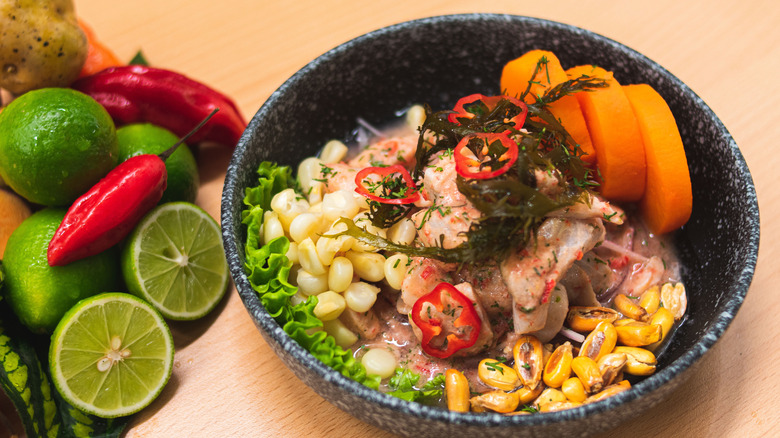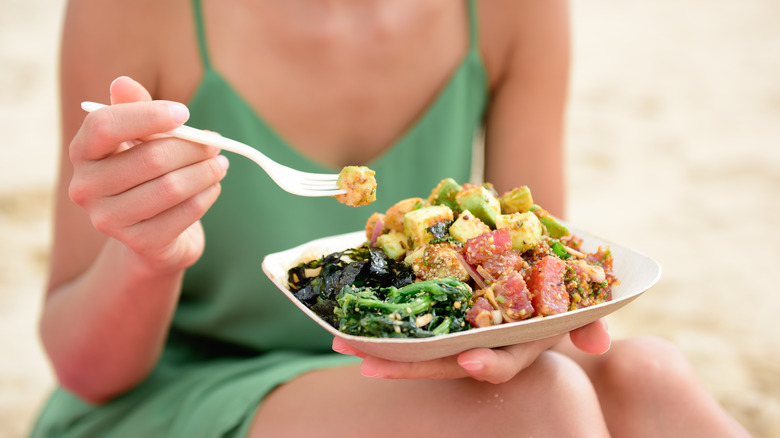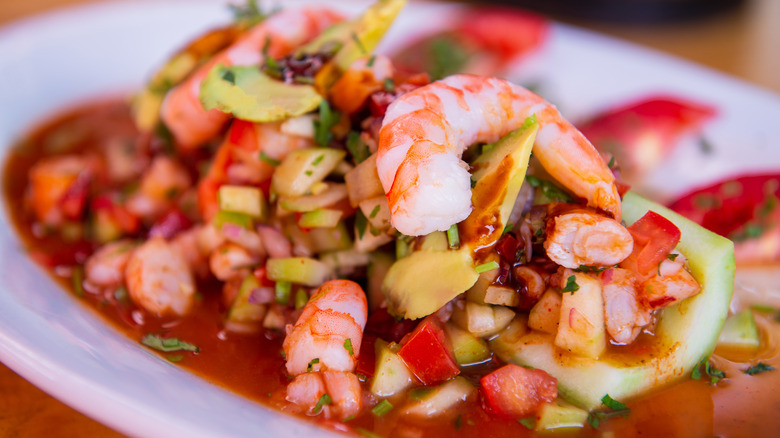The Difference Between Poke And Ceviche Is All In The Acid
Poke and ceviche are two well-known dishes with some similarities and one key difference. Each has its typical accompaniments, but both can include marinated pieces of raw or cooked fish and seafood — though fruits and vegetables can also be in the mix. They both originate from ancient, indigenous, coastal food traditions that far predate immigration and colonization.
The most important difference lies in the marinade. Ceviche is almost always soaked in a citrus marinade, such as a combination of orange and lime juice and zest in this shrimp ceviche tostada recipe. Poke, on the other hand, is dressed with ingredients like sesame oil, soy sauce, and green onions, often taking culinary cues from the myriad of Asian cultures that have influenced the cuisine in Hawaii. The result is not just distinct flavor profiles — bright and zippy versus salty and savory — but also a difference in texture. The raw seafood in ceviche acquires a "cooked" texture after marinating in acidic components, whereas the fish in poke maintains its fresh, buttery softness.
All about poke
Before trendy, fast-casual places popped up across the mainland, poke was — and still is — a mainstay in Hawaii. "Poke" means "chunk" or "cut" in Hawaiian, and can refer to any type of bite-sized, marinated meat, although the term has become more closely associated with seafood. Hawaiian tuna poke is particularly popular, but salmon, tofu, octopus, scallops, crab, shrimp, and various locally caught fish are also readily available.
While modern poke can be a delicious vehicle for all sorts of vegetables, sauces, crunchy items, and pickled goods, it is traditionally served more simply. Lunch counters and grocery stores in Hawaii often serve a scoop of the pre-marinated fish alone or over warm, short-grain sushi rice. Marinades can include ingredients like tart ponzu, sweet chili sauce, spicy mayonnaise, wasabi, limu (a type of algae), or kukui nuts. Hawaiian poke is very flavorful but lacks the puckering acidity of ceviche.
There are numerous variations across Hawaii, but any extra "toppings" are usually mixed in. Elaborate versions with ingredients like edamame, corn, avocado, cucumber, cilantro, pineapple, or watermelon substituted for tuna in vegetarian poke are more of a mainland innovation that has — in some ways — influenced poke back in Hawaii. It's akin to the difference between a traditional Mexican street taco dressed simply, and a loaded Tex-Mex burrito bowl. Both are delicious, but one undoubtedly inspired the other.
Citrusy ceviche
As integral as citrus juice is to classic ceviche, it is a relatively recent addition — meaning it has been part of the recipe for only several hundred years, not a few thousand. The earliest versions were prepared and consumed by indigenous fishermen in present-day Peru, with freshly caught fish dressed with hot chili peppers and seaweed. The theory is that the chilies provided enough acidity to denature the proteins, similarly to citrus juice. When bitter oranges, limes, and lemons arrived post-colonization, they were a natural addition.
Since then, the dish has spread across Central and South America, with many variations reaching far beyond. Today, Peruvian ceviche is often served with sweet potato and roasted, large-kernel corn called choclo. However, even in Peru, the dish has evolved due to significant Japanese influence, resulting in Nikkei cuisine. Nikkei ceviche may include ingredients like soy sauce, sesame oil, and togarashi.
Mexican ceviche typically contains tomatoes, onions, fresh green chilies, cilantro, avocado, and lime juice and is served with tostadas or saltine crackers. Ecuadorian ceviche might include orange juice and be served with green plantain or banana chips known as chifles or patacones — disks of double-fried, smashed green plantain. Countries along the Caribbean coast might incorporate coconut milk in some versions. Regardless, expect to see fish or seafood with an appearance and texture akin to being cooked with heat.



